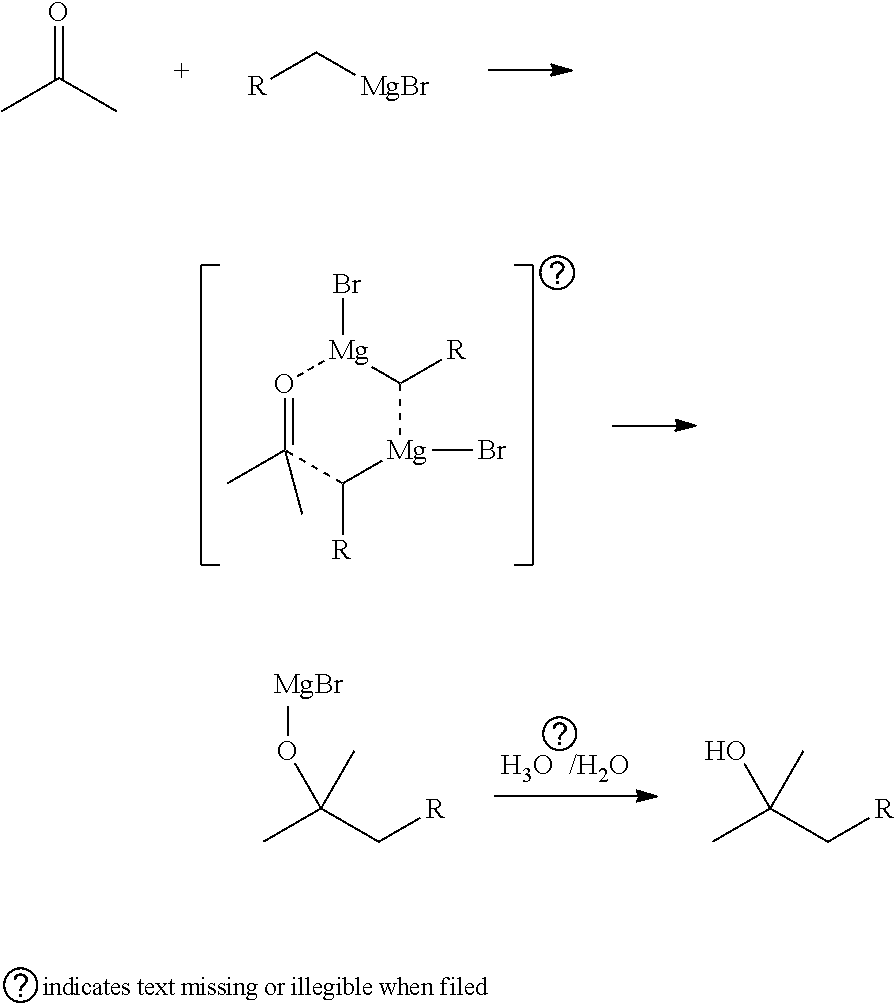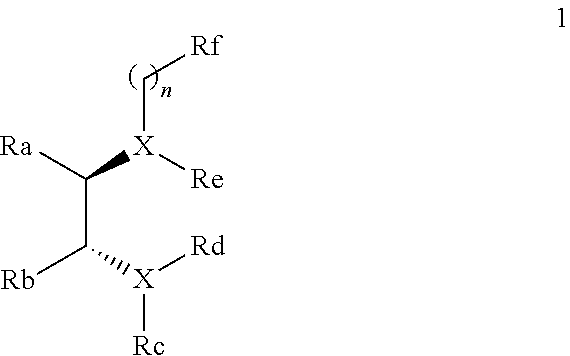Chiral diamine compounds for the preparation of chiral alcohols and chiral amines
a technology of chiral diamine and compound, which is applied in the preparation of carbonyl compounds, organic chemistry, chemistry apparatus and processes, etc., can solve the problems of reducing yield, asymmetric c—c bond formation by the grignard reaction, and being among the most poorly developed fields of organic synthesis
- Summary
- Abstract
- Description
- Claims
- Application Information
AI Technical Summary
Benefits of technology
Problems solved by technology
Method used
Image
Examples
example 1a
Preparation of the Chiral Trans-Diamines
[0159]The preparation of the chiral trans-diamine of formula (1a) and (1b) may he represented by the reaction scheme A:
where R1 is equivalent to Ri described hereinabove and R2 is equivalent to Riii described hereinabove. For the ligand of formula (1a), R1 and R2 are both tert-butyl. For the ligand of formula (1b), R1 is CF3 and R2 is hydrogen. The ligands of formula (1a) and (1b) have the following chemical structures:
[0160]Both of the chiral trans-diamines of formula (1a) and (1b) were prepared from enantiomerically pure mono-BOC protected cyclohexane diamine in three steps (a) to (c).
[0161]Materials
[0162]Enantiomerically pure (>99% ee) (R,R) cyclohexane diamine was prepared according to the method disclosed in D. G. Gilheany (2003). The free amine was then protected with a mono-BOC protecting group as described in Viresh et al (2010). Salicylaldehyde was used directly, without purification.
[0163]Method steps (a) to (c) will now be described...
example 2
General Procedure for Addition of Grignard Reagents to Ketones in Presence of Chiral Ligand of Formula (1)
[0264]The general procedure followed for the preparation of a chiral alcohol in the presence of chiral ligand of formula (1) was as follows:
[0265]Ligand 1. (38 mg, 0.1 mmol, 1.0 eq.) and a ketone (0.1 mmol, 1.0 eq.) were dissolved in 0.75 mL of dry toluene under nitrogen atmosphere and cooled to −78° C. A Grignard reagent in toluene / ether 6:1, 0.43M (0.21 mmol, 2.1 eq.) was added slowly dropwise. The mixture was agitated at −78° C. and monitored by HPLC (GC) until no more product formation was detected. The reaction was quenched by addition of isopropyl alcohol (IPA) / water (2 mL), followed by saturated. NH4Cl (2 mL) and heptane (2 mL) and mixture was allowed to heat to room temperature. The aqueous layer was separated and extracted with heptane (3×5 mL). The organic phases were combined, washed with 20% aqueous solution of acetic acid (3×5 mL) water (3×5 mL), brine (5 mL) and dr...
example 3
Preparation of Chiral Alcohols using the Ligand of Formula (1a)
a) 2-phenyl-2-butanol (compound of Formula 3a)
[0267]
[0268]Ligand 1a (38 mg, 0.1 mmol, 1.0 eq.) was dissolved in 0.5 ml of dry toluene and 0.25 ml of 0.4M acetophenone in dry toluene was added. The mixture was cooled to −78° C. 0.07 ml of ethyl magnesium bromide (3M in ether) was diluted to 0.5 ml with dry toluene and added slowly dropwise over 30 minutes. The mixture was agitated at −78° C. for 1 hour and quenched by addition of IPA / water (2 mL). Followed by saturated NH4Cl (2 mL) and heptane (2 mL). The mixture was allowed to heat to room temperature. The aqueous layer was separated and extracted with heptane (3×5 mL). The organic phases were combined, washed with 20% aqueous solution of acetic acid (3×5 mL), water (3×5 mL), brine (5 mL) and dried over anhydrous Na2SO4. The solvent was removed by rotary evaporator.
[0269]The crude product was purified by flash chromatography using EtOAc / cyclohexane mixture as eluent to y...
PUM
 Login to View More
Login to View More Abstract
Description
Claims
Application Information
 Login to View More
Login to View More - R&D
- Intellectual Property
- Life Sciences
- Materials
- Tech Scout
- Unparalleled Data Quality
- Higher Quality Content
- 60% Fewer Hallucinations
Browse by: Latest US Patents, China's latest patents, Technical Efficacy Thesaurus, Application Domain, Technology Topic, Popular Technical Reports.
© 2025 PatSnap. All rights reserved.Legal|Privacy policy|Modern Slavery Act Transparency Statement|Sitemap|About US| Contact US: help@patsnap.com



